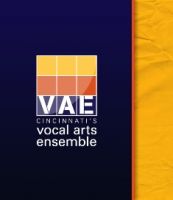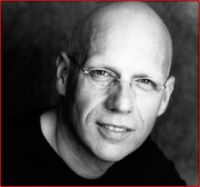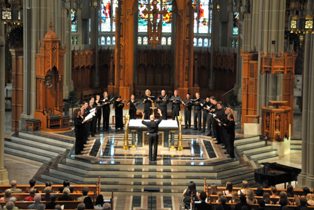Guest writer Thom Mariner is co-publisher of Express Cincinnati and a professional baritone. He writes about the arts in Express Cincinnati's new EXP/arts insert. Thom submits this review of the opening concert of the Cincinnati Vocal Arts Ensemble's 2009-2010, 30th anniversary season, which took place November 6 at St. Peter in Chains Cathedral and was led by the VAE's new music director Donald Nally. Access Express online at www.expresscincinnati.com
Almost everything about this first concert of the next era of Cincinnati’s professional vocal ensemble delivered the message of “new:” the logo and brand identity, the audience, singers, music, and – most important – the leadership and vision of new music director, Donald Nally.

So what does one do when inheriting an institution like The Vocal Arts Ensemble of Cincinnati? Entering the 30th anniversary season, Nally is only VAE’s third music director. It appears that Nally has kept what is best about the organization and is beginning to paint the next canvas with his own brush.

First, the brand: Gone are the filigree and flourish of the past. The new look is sharp, contemporary and bold. Rather than changing the name entirely, Nally has taken what was given and made it cleaner and clearer. “The Vocal Arts Ensemble of Cincinnati” is now “VAE: Cincinnati’s vocal arts ensemble.” Most people have found it easier to say “VAE” anyway – why not make it official?
The audience: The word must be out about the “new” direction, because the audience has taken a definite step backwards…in age, that is. While many VAE faithful were in attendance, the percentage of younger heads was definitely higher than in the past – a positive sign for the future.
The singers: There are some new faces within the ranks of VAE’s 22 members. The fresh ears of a new conductor seek different timbres and combinations. Eschewing the formality of tux and gown, the attire is simple and casual: black shirts and slacks. A grand arch of individual music stands encircled the conductor, supplanting the squeaky risers and awkwardly-supported folders of the past.

The music: The tag line for VAE’s season brochure says “listen to today,” and that’s exactly what we did. The music in this concert was written since 1972, with all but one piece coming from the last 20 years.
“Creator of the stars of night” (2000), by Bermuda-born Gabriel Jackson (1962), set the tone for the evening. A medieval-like drone provided the foundation for the interplay of voices above, weaving a texture sounding simultaneously old and new. It prepared one’s ears for the journey to come.
Byron Adams’ (1955) “Ashes of Soldiers” (2007) is adapted from Walt Whitman’s poem, part of “Leaves of Grass.” The subject matter here calls for denser and darker music, evoking the fear and sorrow of lives lost. But all hope is not abandoned, as evidenced by Whitman’s call to “Make these ashes to nourish and blossom” and the composer’s exquisite coda framed upon the two simple words: “O love.”
The centerpiece of the program was “Cantos Sagrados” (Sacred Songs), written in 1990 by Scottish composer, James MacMillan (1959). Painting the picture of political repression in Latin America, this is music meant to alarm and disturb and it does so with profound effect. It is not always easy to listen to, but that, frankly, seems to be the point. It opens with anguished cries from the chorus and fiendish bursts from the organ, played brilliantly by Christina Haan, as people spread the word of yet another body discovered floating in the river.
Each of the three sections of “Cantos” is an interweaving of the suffering voices of those oppressed with the religious words that comfort and sustain them – Latin texts from the Mass and a hymn that serve as comfort in times of need.
There are huge swings of emotion here, from emotional outbursts to hushed silence, but even that silence appears restless and unsettled. There are dissonances amidst the silence that coat the listener with a heavy blanket of oppression – gentle but insistent. The effect was profound and unsettling, yet fascinating.
After intermission, the mood turned reflective with “Gloria (Everywhere)” (2007) by American-born, Turkish-raised Kamran Ince (1960). The music is mystical and atmospheric, undulating like shifting sands. It is full of shapes and gradients, with Ince painting the text with vivid images, such as those of “Moslems and Christians and Jews” alternately “raising their hands to the sky” and eventually coming together as one: “Their chanting voice in unison begins to arrive.”
As a means of transition, Nally took the opportunity to then address the audience for the first time, expressing his gratitude for their attendance and inviting everyone to a reception following to meet the singers, discuss the music, etc. It served as a palate cleanser and established the mood for what was to follow.
Jonathan Dove’s (1959) “Seek him that maketh the seven stars” (1995) displayed an overt expression of religious ecstasy with its glittering brilliant toccata-like organ accompaniment and joyful, sumptuous eyes-wide-open vocal writing. The effect was exhilarating and liberating, taking the audience into an entirely different place and time. The singing here was full-throated and rapturous, conveying a breathless, almost frantic search for the Creator.
The concert closed with an opulent dessert: Herbert Howells’ “Now abideth Faith, Hope and Charity,” written way back in 1972. Howells (1892-1983) has a singular place among Anglican church composers, with his soaring, seamless lines and intricate fabric. His music is particularly beloved by choral singers, so this was a gift to both the chorus and audience alike, and Haan’s lush organ accompaniment wrapped the entire cathedral in sound.
It was only in reflection that one realized the nature of the emotional journey on which Nally had taken us: from simple expressions of reverence to the anguish of loss and the horror of oppression, then turning inward to the peace and tranquility of personal reflection – only to break out again in joy and delight at the human capacity for goodness and love.
The performance: While there were moments with which one could quibble from a performance perspective, this was by all accounts an auspicious debut. Given the intensely difficult music and being the first public appearance for this new group, there were many remarkable moments. The overall sound of the ensemble is rich and beautiful and unified. The St. Peter in Chains performing space is fairly tubby in its resonance, so diction suffered at times and there were a few tuning and intonation problems, but these were passing glitches in an otherwise rewarding evening.
What Nally brings to the podium during performance is a solidity and clarity of expression that can only provide confidence for the singers as they manage all the intricacies of the fiercely difficult, but satisfying music. His gestures are straightforward, yet expressive. He stays out of the performers’ way and lets them make the music.
Nally’s vision is a bold and somewhat risky one. No previous local classical ensemble has declared its intent to honor and explore the present in this way before. One can only hope that people will view the word “new” as an opportunity, rather than a barrier, and come experience VAE to hear for themselves.